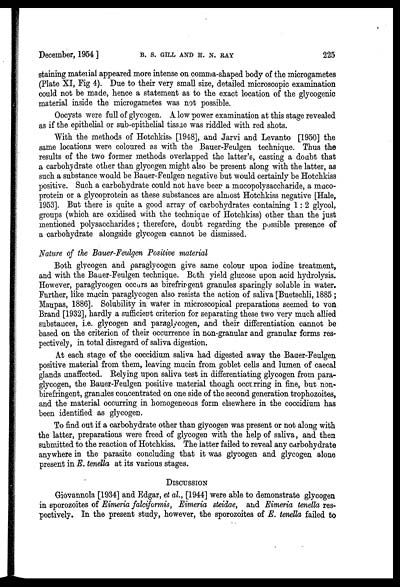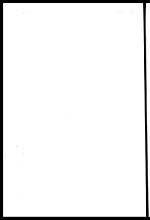Medicine - Veterinary > Veterinary colleges and laboratories > Indian journal of veterinary science and animal husbandry > Volumes 24-25, 1954-1955 > Volume 24 > Glycogen and its probable significance in Eimeria tenella (Railliet and Lucet, 1891)
(245) Page 225
Download files
Individual page:
Thumbnail gallery: Grid view | List view

December, 1954 ] B. S. GILL AND H. N. RAY 225
staining material appeared more intense on comma-shaped body of the microgametes
(Plate XI, Fig 4). Due to their very small size, detailed microscopic examination
could not be made, hence a statement as to the exact location of the glycogenic
material inside the microgametes was not possible.
Oocysts were full of glycogen. A low power examination at this stage revealed
as if the epithelial or sub-epithelial tissue was riddled with red shots.
With the methods of Hotchkiss [1948], and Jarvi and Levanto [1950] the
same locations were coloured as with the Bauer-Feulgen technique. Thus the
results of the two former methods overlapped the latter's, casting a doubt that
a carbohydrate other than glycogen might also be present along with the latter, as
such a substance would be Bauer-Feulgen negative but would certainly be Hotchkiss
positive. Such a carbohydrate could not have beer a mucopolysaccharide, a muco-
protein or a glycoprotein as these substances are almost Hotchkiss negative [Hale,
1953]. But there is quite a good array of carbohydrates containing 1: 2 glycol,
groups (which are oxidised with the technique of Hotchkiss) other than the just
mentioned polysaccharides; therefore, doubt regarding the possible presence of
a carbohydrate alongside glycogen cannot be dismissed.
Nature of the Bauer-Feulgen Positive material
Both glycogen and paraglycogen give same colour upon iodine treatment,
and with the Bauer-Feulgen technique. Both yield glucose upon acid hydrolysis.
However, paraglycogen occurs as birefringent granules sparingly soluble in water.
Further, like mucin paraglycogen also resists the action of saliva [Buetschli, 1885 ;
Maupas, 1886]. Solubility in water in microscopical preparations seemed to von
Brand [1932], hardly a sufficient criterion for separating these two very much allied
substances, i.e. glycogen and paraglycogen, and their differentiation cannot be
based on the criterion of their occurrence in non-granular and granular forms res-
pectively, in total disregard of saliva digestion.
At each stage of the coccidium saliva had digested away the Bauer-Feulgen
positive material from them, leaving mucin from goblet cells and lumen of caecal
glands unaffected. Relying upon saliva test in differentiating glycogen from para-
glycogen, the Bauer-Feulgen positive material though occurring in fine, but non-
birefringent, granules concentrated on one side of the second generation trophozoites,
and the material occurring in homogeneous form elsewhere in the coccidium has
been identified as glycogen.
To find out if a carbohydrate other than glycogen was present or not along with
the latter, preparations were freed of glycogen with the help of saliva, and then
submitted to the reaction of Hotchkiss. The latter failed to reveal any carbohydrate
anywhere in the parasite concluding that it was glycogen and glycogen alone
present in E. tenella at its various stages.
DISCUSSION
Giovannola [1934] and Edgar, et al., [1944] were able to demonstrate glycogen
in sporozoites of Eimeria falciformis, Eimeria steidae, and Eimeria tenella res-
pectively. In the present study, however, the sporozoites of E. tenella failed to
Set display mode to: Large image | Zoom image | Transcription
Images and transcriptions on this page, including medium image downloads, may be used under the Creative Commons Attribution 4.0 International Licence unless otherwise stated. ![]()
| Permanent URL | https://digital.nls.uk/75489961 |
|---|




